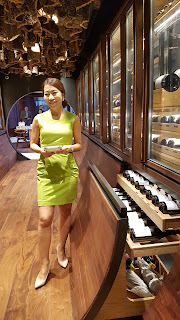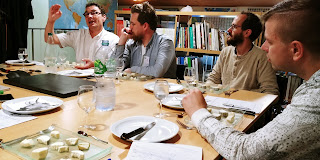 |
| Inside the mobile cheese truck in the 1960s |
In 1983, his elder son Hervé joined his father in the business, after having gained work experience across the country with cheese retailers as well as with cheese producers, and decided to take up a permanent stall at the Halles Diderot in Roanne. This was soon followed by other shops in Renaison and Montbrison. It was around the same time when the affinage cellars at Saint-Haon-le-Châtel were created. Laurent joined his brother to help develop the retail side, leaving Hervé to focus on sourcing the best quality and authentic cheeses for their discerning clients, while supporting traditional farmstead practices. Mons now offers around 250 cheeses year round, depending on the season and availability. Hervé went on to gain the prestigious title of Meilleur Ouvrier de France (MOF) in 2000.

Apart from the retail business, Laurent was also tasked with the formalisation of staff and client training. Thus was born Mons Formation (formerly Opus Caseus) in 2001. Initially the training was conducted in French. When Laurent wanted to reach out to their clients and other cheese professionals in other countries, he was introduced to Susan Sturman (by his brother actually)! The duo created the Anglophone Academie MonS in 2012. The English-language based training academy has grown to a network of training associates in the US, Brazil, Japan, Russia and Italy. Today, Academie MonS (www.academie-mons.com) provides training in different aspects of the cheese business, including retail, retail management, ripening (affinage), cheesemaking as well as city tours to world cities with a strong cheese culture.
 |
| Laurent Mons and Susan Sturman |
Their adherence to strict safety and hygiene standards applies to all aspects. I noticed how the instructions on how to wash hands and keep the toilets clean were the most detailed and thoughtful I had ever seen, and with pictures to demonstrate!
Mons people believe in constantly striving to improve. Driving this desire or obsession is a strong conviction in the ability of teamwork, a strong innovative spirit, and the ability to question status quo. From the days of just cheese retailing to cheese affinage and now cheesemaking, the company has gone through a number of transformations that have required substantial investment in time and resources, backed by visionary foresight and firm conviction. An example being the investment in the immense project of rebuilding the affinage facilities at Saint-Haon-le-Châtel into a state-of-the-art complex of affinage facilities, using their own unique concept and design (patent pending), a project that took two years to complete (2015-2016). The design process took into consideration the optimisation of human and material flow, future capacity requirements, aerodynamics and humidity controls, and safety and hygiene requirements.
There is a very human side too - Mons people have their unique sense of humour. An example is the cheese 1924. To put this into context, Roquefort was granted its AOC in 1925. Hervé and his team created their own version of blue cheese 1924 from a mix of sheep and cow milk, perhaps a defiant sign to show that their creation was even more original. [Author’s note: We tasted this during the sensory analysis on the course. It is a very harmonious blue cheese, with the salt deftly balancing the acidity, evenly spread blue veins and a creamy texture that allows the cheese to melt in the mouth. The faint buttery and nutty flavour complements the blue mineral flavour so well, adding much complexity. Finish is long and very fine.]
As the week of training drew to an end, I gingerly approached Laurent if he would be happy to be interviewed by me, not quite sure what his response would be…. He said yes! So let’s find out: Who is Laurent Mons?
 |
| Laurent Mons |
IN: Was it your childhood dream to work in the cheese industry? What is your dream career? When did you decide to join the family business?
LM: In fact, I wanted to be a journalist or actor (more like a comedian as I do not have the look of Leonardo di Caprio!!) or teacher… [Author’s note: For those of you who have not met Laurent, he has successfully combined his comic acting skills with his teaching capability at Academie MonS. He often had us in stitches!]
IN : What is the Mons philosophy? LM: To be honest, straightforward and direct. We try to do the best possible, even with the least important tasks. To share and to instill a team spirit.
To hold true to the human values you inherit from the family and to transport them to the professional domaine. Never to shine just for the sake of shining. Help your business partners succeed and cherish their success stories!
To have all the knowhow!!!
IN: Which of the two is more important for you: The Auvergne or Mons?
LM: The two are related. Our roots are in the Auvergne and the Mons family are the branches.
IN : What is your vision/ambition for Academie Mons?
LM: A multi-cultural team where each person enriches the other. [We value] people who are humble and loyal. [We foster] a community that is serious and humane at the same time.
I envisage it as more than just a social network, rather like a network of neurons.
IN: How do you keep yourself being challenged in the business/in life?
LM: Thanks to all of you who join us at Mons Formation. Thanks to all the people who believe in what we do. This consistently provides us with challenges.
I see it as a personal challenge to demonstrate that training is not worth less than operations, and that our ideas promote trade.
It is a challenge in the family where you are being stuck with being the Number 2 and you know you will be nobody if you do not create anything.
IN: Who is your hero? Who has inspired you most? Why?
LM: On the professional front, definitely my brother. In terms of human relations, definitely my father.
IN: You are the second generation in the business. Is the third generation in place? What have you done to prepare the third generation?
IN : What is the Mons philosophy? LM: To be honest, straightforward and direct. We try to do the best possible, even with the least important tasks. To share and to instill a team spirit.
To hold true to the human values you inherit from the family and to transport them to the professional domaine. Never to shine just for the sake of shining. Help your business partners succeed and cherish their success stories!
To have all the knowhow!!!
IN: Which of the two is more important for you: The Auvergne or Mons?
LM: The two are related. Our roots are in the Auvergne and the Mons family are the branches.
IN : What is your vision/ambition for Academie Mons?
LM: A multi-cultural team where each person enriches the other. [We value] people who are humble and loyal. [We foster] a community that is serious and humane at the same time.
I envisage it as more than just a social network, rather like a network of neurons.
 |
| The multi-cultural training team at Academie MonS |
IN: How do you keep yourself being challenged in the business/in life?
LM: Thanks to all of you who join us at Mons Formation. Thanks to all the people who believe in what we do. This consistently provides us with challenges.
I see it as a personal challenge to demonstrate that training is not worth less than operations, and that our ideas promote trade.
It is a challenge in the family where you are being stuck with being the Number 2 and you know you will be nobody if you do not create anything.
IN: Who is your hero? Who has inspired you most? Why?
LM: On the professional front, definitely my brother. In terms of human relations, definitely my father.
 |
| Hubert Mons and his two sons |
IN: You are the second generation in the business. Is the third generation in place? What have you done to prepare the third generation?
LM: We are preparing the third generation, but it is a bit like a “prototype”, we keep it a secret at this stage. It is in the incubator!
 |
| Herve and Laurent inside Le Tunnel de la Collonge |
IN : Is cheese a part of culture or lifestyle?
LM: Yes, it is an essential part. More globally, it is a part of the world of food, cooking and history.
IN: What is your favourite cheese/wine/beverage pairing?
LM: A farmstead Saint Nectaire paired with a Bandol red. [Author’s note: I must try this!]
 |
| Farmstead Saint Nectaire |
IN: If you were a cheese, which one would it be? And why?
LM: It would be a Salers Tradition. [Author’s note: a farmstead cheese from the Auvergne, that is different from a cheese simply called Salers. Both are AOP cheeses, but to qualify to be Salers Tradition, the milk has to come from Salers cows.]
 |
| AOP Salers Tradition (source: www.aop-salers.com) |



























